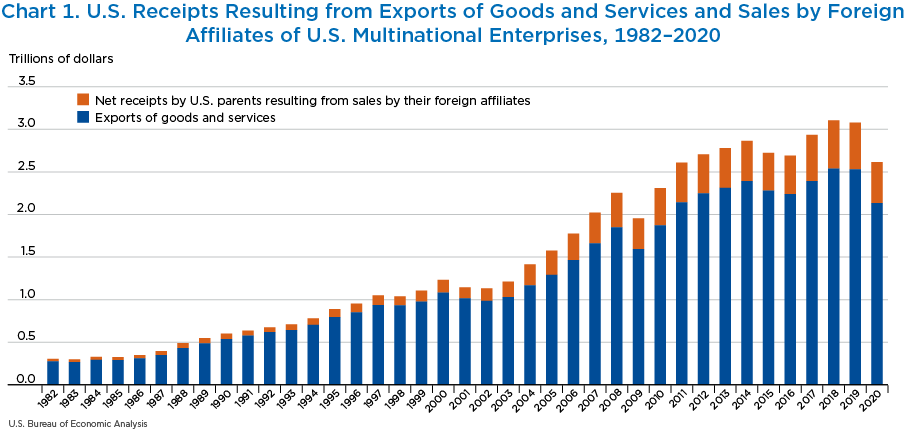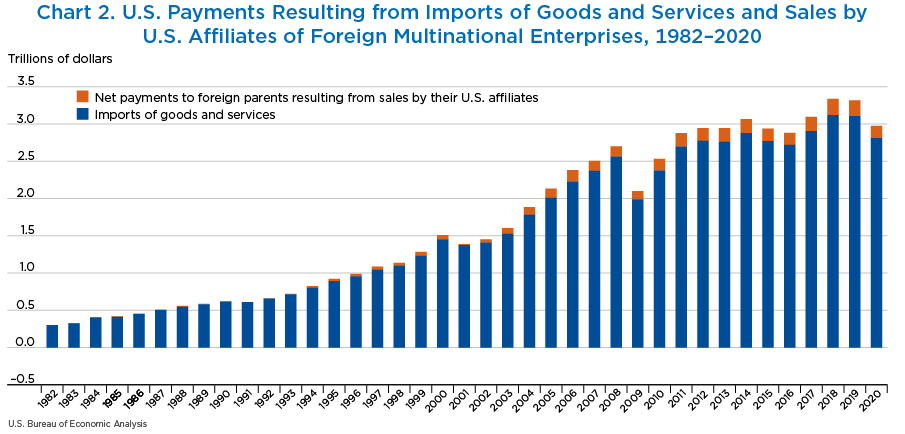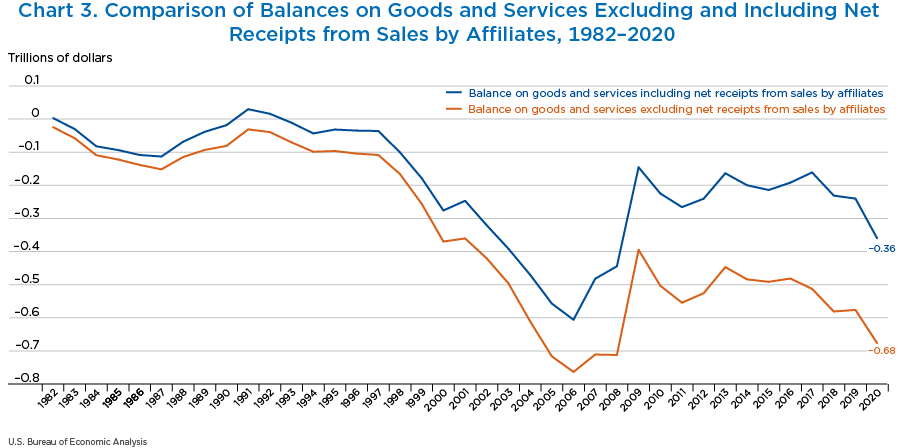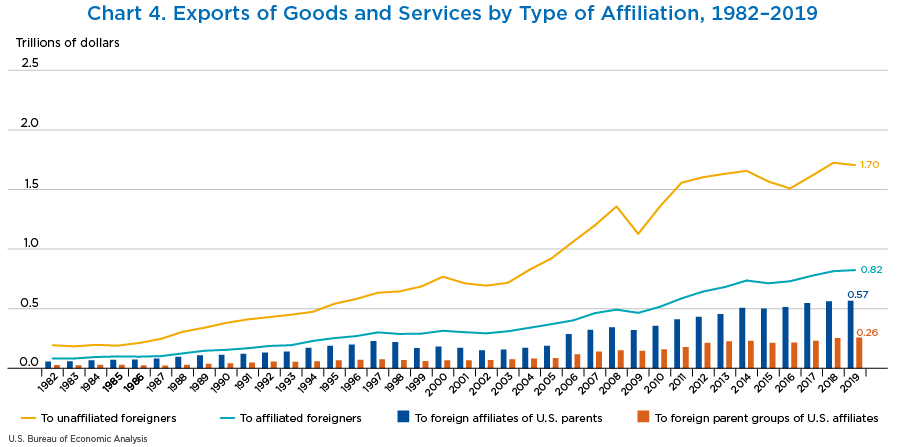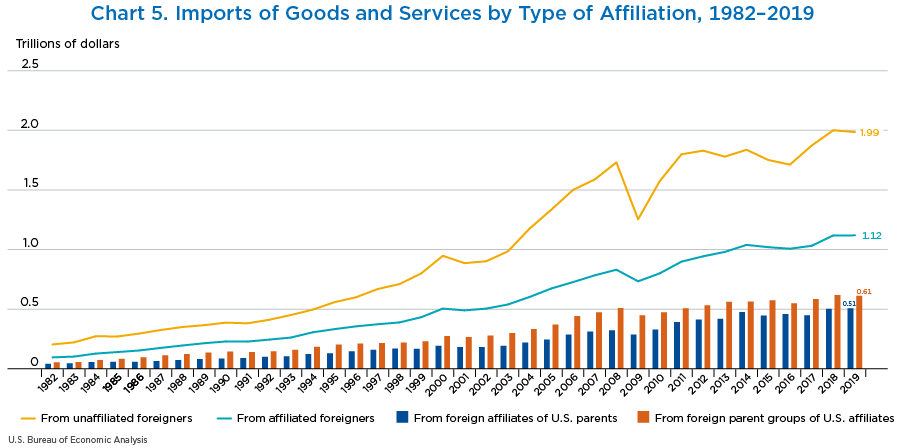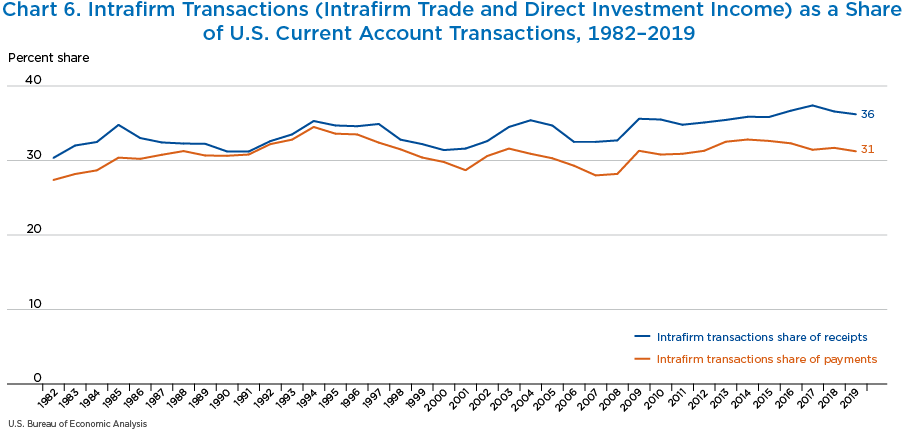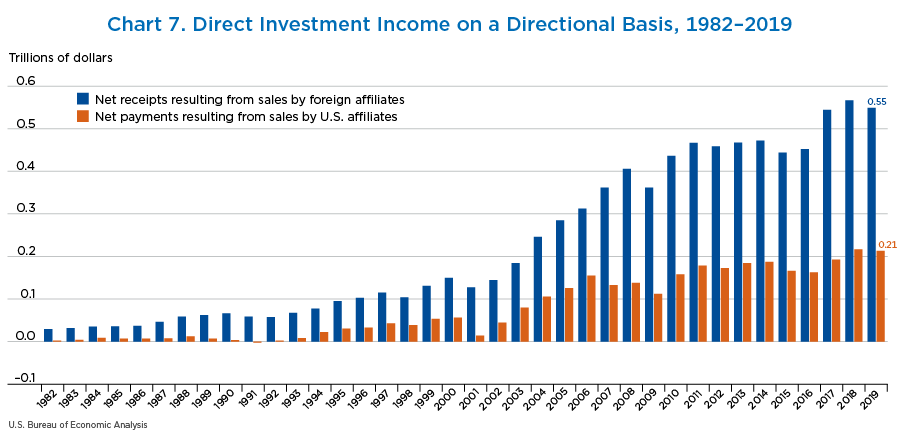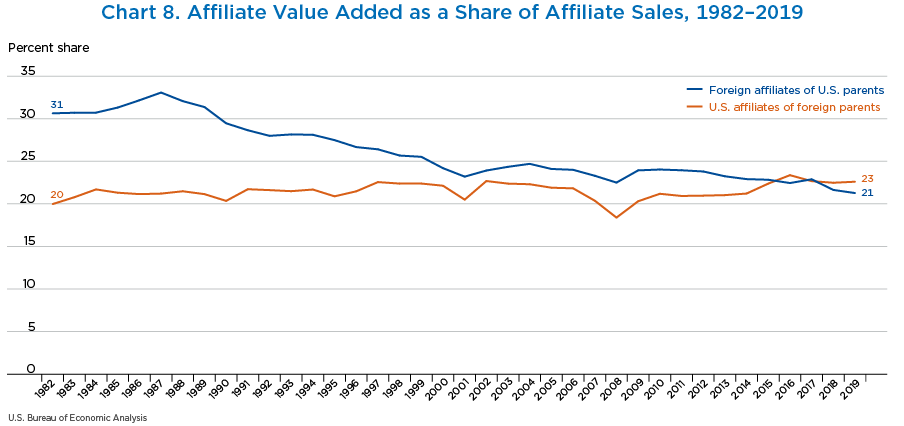An Ownership-Based Framework of the U.S. Current Account, 2020
This report updates the ownership-based framework of the current account of the U.S. International Transactions Accounts (ITAs) prepared by the U.S. Bureau of Economic Analysis (BEA).1 The ownership-based framework presentation is similar to the standard current-account presentation in some fundamental ways. It includes the major aggregates of international trade in goods and services, primary and secondary income, and some key balances, which are also included in the ITAs.
The ownership-based framework highlights the important role that multinational enterprises (MNEs) play in international transactions. This framework shows that direct investment income receipts and payments are the result of substantial sales of goods and services and purchases of labor and other inputs. It also disaggregates trade in goods and services to show trade with affiliated foreigners separately from trade with unaffiliated foreigners.
This updated report includes new summary statistics on the major current-account aggregates for 2020, revised and more detailed statistics for 2019, and revised statistics for earlier years. The updated statistics through 2020 in this report reflect the 2021 annual update of the ITAs, which incorporated newly available and revised source data and other improvements, as well as the 2021 annual update of the associated international services statistics.2 In addition, the updated statistics reflect preliminary results from both the 2019 Benchmark Survey of U.S. Direct Investment Abroad (“outward” direct investment) and the 2019 Annual Survey of Foreign Direct Investment in the United States (“inward” direct investment) as well as revised results from the 2018 annual surveys of outward and inward direct investment.3 The updated statistics also reflect corrections to previously published ownership-based framework statistics for certain data values.4 Technical documentation of the ownership-based framework and a table that presents updated statistics for the most recent years are available on BEA's website.5
The following charts and highlights are based on the updated statistics:
- In 2020, U.S. receipts were $2.62 trillion, reflecting exports of goods and services of $2.13 trillion and net income receipts of U.S. parents resulting from sales by their foreign affiliates of $0.48 trillion. In 2020, U.S. receipts decreased $0.46 trillion, or 15.0 percent, from 2019. The decrease was largely accounted for by a $0.39 trillion decrease in exports of goods and services. The sharp fall in receipts reflects the impact of the COVID-19 pandemic on U.S. international transactions.
- In 2020, U.S. payments were $2.98 trillion, reflecting imports of goods and services of $2.81 trillion and net income payments to foreign parents resulting from sales by their U.S. affiliates of $0.16 trillion. In 2020, U.S. payments decreased $0.34 trillion, or 10.3 percent, from 2019. The decrease was largely accounted by a $0.29 trillion decrease in imports of goods and services. The sharp fall in payments reflects the impact of the COVID-19 pandemic on U.S. international transactions.
- In 2020, the deficit on goods, services, and net income receipts from sales by affiliates—U.S. parents' income receipts from foreign affiliates less U.S. affiliates' income payments to foreign parents—was $0.36 trillion, less than the more narrowly defined deficit on trade in goods and services, which was $0.68 trillion.
- In 2020, the deficit on goods, services, and net income receipts increased $0.12 trillion, reflecting a $0.10 trillion increase in the deficit on trade in goods and services and a $0.02 trillion decrease in the surplus on net income receipts from sales by affiliates.
- Historically, most trade in goods and services represents trade with unaffiliated foreigners rather than intrafirm trade.
- In 2019 (the latest year for which statistics are available),total exports to unaffiliated foreigners were $1.70 trillion and accounted 67 percent of total U.S. exports of goods and services. Total intrafirm exports (or exports to affiliated foreigners) were $0.82 trillion and accounted for 33 percent of total U.S. exports.
- Of intrafirm exports, U.S. parents' exports to their foreign affiliates were $0.57 trillion and accounted for 22 percent of total U.S. exports of goods and services. U.S. affiliates' exports to their foreign parents were $0.26 trillion and accounted for 10 percent of total U.S. exports of goods and services.6
- In 2019, total imports from unaffiliated foreigners were $1.99 trillion and accounted for 64 percent of total U.S. imports of goods and services. Total intrafirm imports were $1.12 trillion and accounted for 36 percent of total U.S. imports.
- Of intrafirm imports, U.S. affiliates' imports from their foreign parents were $0.61 trillion and accounted for 20 percent total U.S. imports. U.S. parents' imports from their foreign affiliates were $0.51 trillion and accounted for 16 percent total U.S. imports.
- Cross-border transactions within MNEs—direct investment income and intrafirm trade in goods and services—account for roughly one-third of all U.S. international transactions, but the share is higher for receipts than payments. In 2019, these transactions accounted for 36 percent of U.S. receipts and 31 percent of U.S. payments.7
- In 2019, net receipts of direct investment income of $0.55 trillion resulted from sales by foreign affiliates of $7.72 trillion less deductions of $7.17 trillion for labor, other inputs, and profits accruing to foreign persons.
- Net payments of $0.21 trillion in 2019 resulted from sales by U.S. affiliates of $5.40 trillion less deductions of $5.19 trillion for labor, other inputs, and profits accruing to U.S. persons.
- Value added by foreign affiliates of U.S. parents as a share of their sales was 21 percent in 2019. Value added by U.S. affiliates of foreign parents as a share of their sales was 23 percent in 2019. The share for foreign affiliates dropped considerably over the period covered by the ownership-based framework statistics, whereas the share for U.S. affiliates has been relatively stable over the period.
- For more information and statistics on the U.S. ITAs, see the BEA website.
- For more information about the 2021 annual update, see Ami Adjoh-Baliki and Jason Sutterley, “Annual Update of the U.S. International Transactions Accounts,” Survey of Current Business 101 (July 2021).
- For more information about the U.S. direct investment abroad survey results, see the BEA website. For more information about foreign direct investment in the United States survey results, see the BEA website.
- Corrections were made for the following lines in table 2 (except where noted) and years: lines 22, 72, 74, and 75: 2006–2013; lines 23, 25, 57, and 59: 1999–2013; lines 42, 44, 45, and 47: 1999–2005; lines 56, 77, 79, and 80: 2006–2010; line 71:
2007–2009; lines 12, 14, 15, 45, 46, and 48 in table 1: 1997. In addition, revisions were made to compute aggregates from unrounded, rather than rounded, components. The corrections and rounding revisions do not affect the underlying ITA, international services, or direct investment statistics used as source data for the ownership-based framework statistics. - For the table and for documentation about the sources and methods used to prepare the ownership-based framework estimates, see “Supplemental Statistics” to the international accounts on BEA's website. For additional information on the ownership-based framework estimates, including information on the sources and methods used to prepare the estimates for the first time, see Obie G. Whichard and Jeffrey H. Lowe, “An Ownership-Based Disaggregation of the U.S. Current Account, 1982–93,” Survey 75 (October 1995): 52–61. For a general review of the issues relating to ownership relationships in international transactions, see J. Steven Landefeld, Obie G. Whichard, and Jeffrey H. Lowe, “Alternative Frameworks for U.S. International Transactions,” Survey 73 (December 1993): 50–61.
- As implied by the chart, these exports include exports both to the foreign parents themselves and exports to other members of the foreign parent group. The foreign parent group of a U.S. affiliate consists of (1) the foreign parent, (2) any foreign person (including a company), proceeding up the foreign parent's ownership chain, that owns more than 50 percent of the entity below it, and (3) any foreign entity, proceeding down the ownership chain(s) of each of these members, that is owned more than 50 percent by the foreign entity above it. The foreign parent group excludes any foreign entity proceeding down these ownership chains that is not owned more than 50 percent by another member of the foreign parent group.
- The statistics on U.S. international transactions for 1982–1998 exclude secondary income receipts and payments (or current transfers) in total U.S. receipts and payments because secondary income for 1982–1998 is presented on a net basis.
